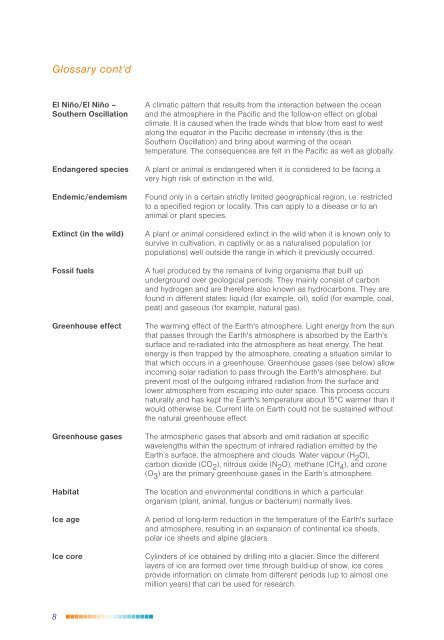Climate change in the UKOTs an overview of the ... - JNCC - Defra
Climate change in the UKOTs an overview of the ... - JNCC - Defra
Climate change in the UKOTs an overview of the ... - JNCC - Defra
You also want an ePaper? Increase the reach of your titles
YUMPU automatically turns print PDFs into web optimized ePapers that Google loves.
Glossary cont’d<br />
El Niño/El Niño –<br />
Sou<strong>the</strong>rn Oscillation<br />
End<strong>an</strong>gered species<br />
Endemic/endemism<br />
Ext<strong>in</strong>ct (<strong>in</strong> <strong>the</strong> wild)<br />
Fossil fuels<br />
Greenhouse effect<br />
Greenhouse gases<br />
Habitat<br />
Ice age<br />
Ice core<br />
8<br />
A climatic pattern that results from <strong>the</strong> <strong>in</strong>teraction between <strong>the</strong> oce<strong>an</strong><br />
<strong>an</strong>d <strong>the</strong> atmosphere <strong>in</strong> <strong>the</strong> Pacific <strong>an</strong>d <strong>the</strong> follow-on effect on global<br />
climate. It is caused when <strong>the</strong> trade w<strong>in</strong>ds that blow from east to west<br />
along <strong>the</strong> equator <strong>in</strong> <strong>the</strong> Pacific decrease <strong>in</strong> <strong>in</strong>tensity (this is <strong>the</strong><br />
Sou<strong>the</strong>rn Oscillation) <strong>an</strong>d br<strong>in</strong>g about warm<strong>in</strong>g <strong>of</strong> <strong>the</strong> oce<strong>an</strong><br />
temperature. The consequences are felt <strong>in</strong> <strong>the</strong> Pacific as well as globally.<br />
A pl<strong>an</strong>t or <strong>an</strong>imal is end<strong>an</strong>gered when it is considered to be fac<strong>in</strong>g a<br />
very high risk <strong>of</strong> ext<strong>in</strong>ction <strong>in</strong> <strong>the</strong> wild.<br />
Found only <strong>in</strong> a certa<strong>in</strong> strictly limited geographical region, i.e. restricted<br />
to a specified region or locality. This c<strong>an</strong> apply to a disease or to <strong>an</strong><br />
<strong>an</strong>imal or pl<strong>an</strong>t species.<br />
A pl<strong>an</strong>t or <strong>an</strong>imal considered ext<strong>in</strong>ct <strong>in</strong> <strong>the</strong> wild when it is known only to<br />
survive <strong>in</strong> cultivation, <strong>in</strong> captivity or as a naturalised population (or<br />
populations) well outside <strong>the</strong> r<strong>an</strong>ge <strong>in</strong> which it previously occurred.<br />
A fuel produced by <strong>the</strong> rema<strong>in</strong>s <strong>of</strong> liv<strong>in</strong>g org<strong>an</strong>isms that built up<br />
underground over geological periods. They ma<strong>in</strong>ly consist <strong>of</strong> carbon<br />
<strong>an</strong>d hydrogen <strong>an</strong>d are <strong>the</strong>refore also known as hydrocarbons. They are<br />
found <strong>in</strong> different states: liquid (for example, oil), solid (for example, coal,<br />
peat) <strong>an</strong>d gaseous (for example, natural gas).<br />
The warm<strong>in</strong>g effect <strong>of</strong> <strong>the</strong> Earth's atmosphere. Light energy from <strong>the</strong> sun<br />
that passes through <strong>the</strong> Earth's atmosphere is absorbed by <strong>the</strong> Earth's<br />
surface <strong>an</strong>d re-radiated <strong>in</strong>to <strong>the</strong> atmosphere as heat energy. The heat<br />
energy is <strong>the</strong>n trapped by <strong>the</strong> atmosphere, creat<strong>in</strong>g a situation similar to<br />
that which occurs <strong>in</strong> a greenhouse. Greenhouse gases (see below) allow<br />
<strong>in</strong>com<strong>in</strong>g solar radiation to pass through <strong>the</strong> Earth's atmosphere, but<br />
prevent most <strong>of</strong> <strong>the</strong> outgo<strong>in</strong>g <strong>in</strong>frared radiation from <strong>the</strong> surface <strong>an</strong>d<br />
lower atmosphere from escap<strong>in</strong>g <strong>in</strong>to outer space. This process occurs<br />
naturally <strong>an</strong>d has kept <strong>the</strong> Earth's temperature about 15°C warmer th<strong>an</strong> it<br />
would o<strong>the</strong>rwise be. Current life on Earth could not be susta<strong>in</strong>ed without<br />
<strong>the</strong> natural greenhouse effect.<br />
The atmospheric gases that absorb <strong>an</strong>d emit radiation at specific<br />
wavelengths with<strong>in</strong> <strong>the</strong> spectrum <strong>of</strong> <strong>in</strong>frared radiation emitted by <strong>the</strong><br />
Earth’s surface, <strong>the</strong> atmosphere <strong>an</strong>d clouds. Water vapour (H 2 O),<br />
carbon dioxide (CO 2 ), nitrous oxide (N 2 O), meth<strong>an</strong>e (CH 4 ), <strong>an</strong>d ozone<br />
(O 3 ) are <strong>the</strong> primary greenhouse gases <strong>in</strong> <strong>the</strong> Earth’s atmosphere.<br />
The location <strong>an</strong>d environmental conditions <strong>in</strong> which a particular<br />
org<strong>an</strong>ism (pl<strong>an</strong>t, <strong>an</strong>imal, fungus or bacterium) normally lives.<br />
A period <strong>of</strong> long-term reduction <strong>in</strong> <strong>the</strong> temperature <strong>of</strong> <strong>the</strong> Earth's surface<br />
<strong>an</strong>d atmosphere, result<strong>in</strong>g <strong>in</strong> <strong>an</strong> exp<strong>an</strong>sion <strong>of</strong> cont<strong>in</strong>ental ice sheets,<br />
polar ice sheets <strong>an</strong>d alp<strong>in</strong>e glaciers.<br />
Cyl<strong>in</strong>ders <strong>of</strong> ice obta<strong>in</strong>ed by drill<strong>in</strong>g <strong>in</strong>to a glacier. S<strong>in</strong>ce <strong>the</strong> different<br />
layers <strong>of</strong> ice are formed over time through build-up <strong>of</strong> snow, ice cores<br />
provide <strong>in</strong>formation on climate from different periods (up to almost one<br />
million years) that c<strong>an</strong> be used for research.

















